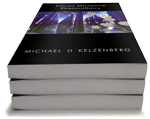 I defended my PhD thesis on May 19, 2010. I'm pleased to offer an electronic version of this thesis below, which includes additional appendices and source code examples, navigational links, and corrections to several errors I identified in the original version.
I defended my PhD thesis on May 19, 2010. I'm pleased to offer an electronic version of this thesis below, which includes additional appendices and source code examples, navigational links, and corrections to several errors I identified in the original version.
Thesis by
Michael David Kelzenberg
The favorable bandgap and natural abundance of Si, combined with the large expertise base for semiconductor wafer processing, have led to the use of wafer-based crystalline Si in the vast majority of photovoltaic cells and modules produced worldwide. However the high cost of purifying, crystallizing, and sawing Si wafers has inhibited these photovoltaic energy sources from approaching cost parity with fossil fuels. Crystalline Si microwires, grown by the catalytic vapor-liquid-solid (VLS) chemical vapor deposition process, have recently emerged as promising candidate materials for thin-film photovoltaics—combining low-cost Si deposition techniques with mechanically flexible, high-performance device geometries.
This thesis presents several achievements that have helped to establish the viability of high-performance Si microwire photovoltaics. We begin by developing a comprehensive numerical model of Si microwire-array solar cells, combining finite-element device physics simulations with time-domain optical methods to predict that these devices can exceed 17% solar energy conversion efficiency. We then turn our attention to the optical properties of Si microwire arrays, concerned that the sparsely packed wires might not absorb enough sunlight. However our experiments reveal that simple light-trapping techniques can dramatically improve their absorption, not only permitting them to effectively absorb sunlight using 1/100th as much Si as a wafer, but also leading to an unexpected and fundamentally advantageous absorption enhancement over classical light trapping in planar materials. Techniques are then presented to characterize the material quality of VLS-grown Si wires. Although the growth of these wires is catalyzed by notoriously undesirable metal impurities for crystalline Si (e.g., Au, Ni, and Cu), we find it is nonetheless possible to synthesize high-quality material with remarkable diffusion lengths. By combining these materials with effective surface passivation and a novel junction fabrication technique, we realize single-wire solar cells that achieve open-circuit voltages of 600 mV and with fill factors exceeding 80%. These observations suggest that Si microwires may offer a promising alternative to wafers for cost-effective crystalline Si photovoltaics.
-
Full thesis
307 pages (45 MB PDF)
-
Sentaurus TCAD & Lumerical FDTD integration
41 pages (1.4 MB PDF)
This document contains only Appendix B, "Method of integrating Lumerical FDTD within Sentaurus TCAD." Also available for download are the following files:
 Listing 1: User tooldb file
Listing 1: User tooldb file Listing 2: Lumerical structure generation script
Listing 2: Lumerical structure generation script Listing 3: FDTD execution shell script
Listing 3: FDTD execution shell script Listing 4: MATLAB mesh conversion script
Listing 4: MATLAB mesh conversion script Listing 5: Spectral calculator program, including the MATLAB script, a graphical user interface, and ASTM Air Mass 1.5 spectrum files
Listing 5: Spectral calculator program, including the MATLAB script, a graphical user interface, and ASTM Air Mass 1.5 spectrum files FDTD processing script, a Lumerical CAD script that calculates the absorption and saves optical generation profiles (MATLAB format) following FDTD simulations of wire-array structures
FDTD processing script, a Lumerical CAD script that calculates the absorption and saves optical generation profiles (MATLAB format) following FDTD simulations of wire-array structures 3d2cyl script, a simple MATLAB script for flattening 3D absorption profiles for 2D-cylindrical device physics simulations
3d2cyl script, a simple MATLAB script for flattening 3D absorption profiles for 2D-cylindrical device physics simulations
-
SPCM instrument
16 pages (1.9 MB PDF)
This document contains only Appendix C, which provides information on performing scanning photocurrent microscopy (SPCM) measurements with the WiTEC microscope at the MMRC.
-
Spectrophotometer instrument
58 pages (6.0 MB PDF)
This document contains only Appendix D, which describes the theory and operation of the custom integrating sphere photospectrometer developed during the course of this thesis work.
 Data plotting script, a simple MATLAB script for processing and plotting data measurements from the spectrophotometery system
Data plotting script, a simple MATLAB script for processing and plotting data measurements from the spectrophotometery system
